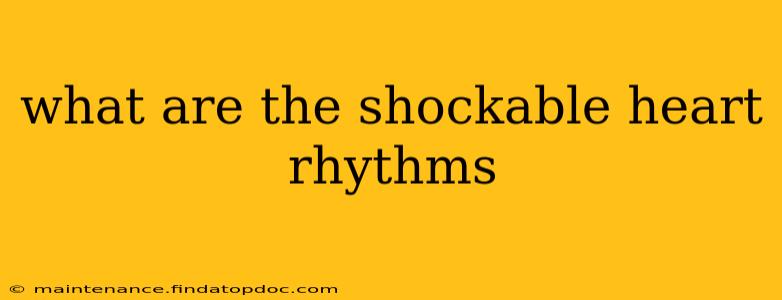Understanding shockable heart rhythms is crucial for anyone involved in emergency medical situations, from paramedics to trained lay rescuers. Defibrillation, the process of delivering a controlled electric shock to the heart, is a life-saving intervention, but it's only effective in specific situations. This article will explore those situations, explaining what makes a heart rhythm "shockable" and what happens when defibrillation is applied.
What Makes a Heart Rhythm Shockable?
The heart's electrical system controls its rhythm. When this system malfunctions, it can lead to arrhythmias—irregular heartbeats. Not all arrhythmias are shockable. Defibrillation aims to reset the heart's electrical activity, allowing it to resume a normal rhythm. Only rhythms characterized by disorganized electrical activity causing the heart to quiver ineffectively (ventricular fibrillation) or beat too fast and ineffectively (pulseless ventricular tachycardia) are considered shockable. These rhythms prevent the heart from pumping blood effectively, leading to cardiac arrest.
What are Ventricular Fibrillation (VF) and Pulseless Ventricular Tachycardia (pVT)?
Ventricular Fibrillation (VF): This is a chaotic, disorganized quivering of the ventricles (the lower chambers of the heart). The heart doesn't pump blood effectively, leading to a rapid loss of consciousness and circulatory collapse. VF is the most common shockable rhythm. On an electrocardiogram (ECG), VF appears as irregular, chaotic waves without discernible QRS complexes.
Pulseless Ventricular Tachycardia (pVT): This is a very rapid heart rhythm originating in the ventricles. While organized compared to VF, the heart beats so fast that it doesn't have enough time to fill with blood between beats. This results in ineffective blood flow, leading to cardiac arrest. Like VF, pVT requires immediate defibrillation. On an ECG, pVT shows rapid, wide QRS complexes.
What Happens When You Defibrillate?
Defibrillation delivers a high-energy electrical shock to the heart. This shock aims to depolarize (reset) a large mass of heart muscle simultaneously. This coordinated depolarization allows the heart's natural pacemaker (the sinoatrial node) to regain control and resume a normal rhythm. It's crucial to remember that defibrillation is not a cure but a way to buy time for further medical intervention. After defibrillation, CPR and advanced life support are essential.
What are the Unshockable Rhythms?
It's equally important to understand which rhythms are not shockable. These include rhythms where the heart has some organized electrical activity, but it's not pumping blood effectively. Examples include:
- Asystole (flatline): There is no electrical activity in the heart.
- Pulseless Electrical Activity (PEA): Electrical activity is present on the ECG, but there is no palpable pulse.
In these cases, CPR and advanced life support measures are the primary treatments. Defibrillation is ineffective and potentially harmful.
How is a Shockable Rhythm Diagnosed?
Shockable rhythms are identified through an electrocardiogram (ECG). Emergency medical services (EMS) personnel use portable ECG machines to analyze the heart rhythm and determine whether defibrillation is necessary. Automated External Defibrillators (AEDs) can also analyze the rhythm and advise whether a shock is recommended.
Can an AED Make a Mistake in Identifying Shockable Rhythms?
While AEDs are highly accurate, they aren't foolproof. Occasionally, an AED may advise against shocking when a shock is indicated, or vice versa. The ultimate decision about defibrillation rests with trained medical professionals.
In conclusion, understanding shockable heart rhythms is crucial for effective emergency response. Prompt recognition of VF and pVT and immediate defibrillation are life-saving interventions in cardiac arrest. Remember that appropriate training is essential before using a defibrillator. This information is for educational purposes only and should not be considered medical advice. Always consult with a healthcare professional for any health concerns.
